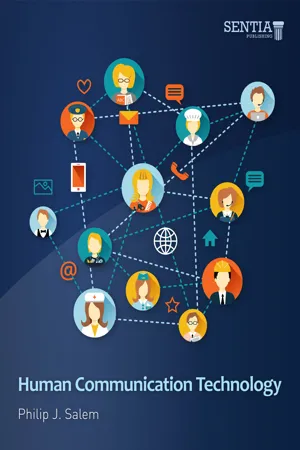HUMAN
COMMUNICATION TECHNOLOGY
Philip J. Salem
Copyright @ 2016 by Philip J. Salem
Sentia Publishing Company has the exclusive rights to reproduce this work, to prepare derivative works from this work, to publicly distribute this work, to publicly perform this work, and to publicly display this work.
All rights reserved. No part of this publication may be reproduced, stored in a retrieval system, or transmitted, in any form or by any means, electronic, mechanical, photocopying, recording, or otherwise, without the prior written permission of the copyright owner.
ISBN: 978-0-9966548-4-5
Printed in the United States of America in Austin, Texas.
TABLE OF CONTENTS
Introduction vi
References ix
Chapter One: Information 1
Differences and Variety 1
Information Processing 4
Reducing Uncertainty 8
Human Information Processing 9
Attention 14
Conclusion 16
References 17
Chapter Two: Human Communication 20
Communication and Human Information Processing 21
Attributes of Human Communication 27
Not Communication 27
Developing Communication 28
Communication Practices 34
References 38
Chapter Three: Technology 41
Types of Information and Human Communication Technologies 42
Face-‐to-‐Face Communication (FtF) 42
Telephone (TEL) 44
Writing and Print (WP) 45
Electronic Mail (EML) 46
Private Electronic Communication (PEC) 47
Public Electronic Communication (BEC) 48
Contemporary Information Technologies 50
Technology Effects 53
Explaining the Effects 56
References 57
Chapter Four: The Adoption of Technology 62
The Evolution of Innovations 62
Genes 63
Memes and Innovations 64
The Innovation Adoption Process 66
Stages of Adoption 66
Framing Innovations 69
Patterns of Adoption 71
Communication and Adoption 73
Communication and Making Sense of an Innovation 74
Communication Networks and Adoption 76
Conclusion 77
References 78
Constructing and Negotiating Self 82
The Nature of Self 82
Sustaining Self 84
Technology and Self 91
Presenting and Negotiating Self Online 91
When Private Becomes Public 94
Complex Self 97
Conclusion 102
References 103
Chapter Six: Making Messages 108
Making Competent Messages 110
Information and Knowledge 111
An Ability to Perform Behaviors 119
Bad Digital Messages 122
Explaining Digital Messages 126
References 129
Chapter Seven: Communication Technology Networks 136
Relationships 137
Communication Networks 139
Communication Technology and Networks 144
How Have Our Personal Networks Changed? 150
References 152
Chapter Eight: Technology and Close Relationships 155
Communicating In Close Relationships 159
Disclosure and Validation 159
Disclosing and Finding Romantic Partners 163
Loneliness and Technology 166
Explaining the Relationships Between HCT and Close Relationships 171
References 174
Chapter Nine: Technology & Communication Resources 180
Understanding Communication Resources 181
Seven Resources 184
Online Communication Resources and Support 188
The Potential for Resources 191
References 192
Chapter Ten: Civic Engagement 196
Civic Engagement Perceptions 198
Commitment 198
Trust 200
Civic Engagement Activities 203
Community 207
The Pattern 213
References 214
Chapter 11: Reality and Technology 217
The Reality of Technology 219
The Technology of Reality 221
Whatever Happened to the News? 223
Virtual Humans 227
Conclusion 230
References 231
INTRODUCTION
Bob Gratz and I began writing about technology in the late 1970s. Later, he would go on to be an active administrator at Texas State University, serving as a chair, dean, academic vice- president, and assistant to the president. I designed one of the first graduate classes about human communication technology in the early 1980s, and I have continued to research and write about a fascinating area.
When Bob and I first started writing about technology, we wrote about television, but we soon turned out attention to computer use. We both recognized the “concerns” people had about these technologies were similar, and I found some literature tracing current worries back to headlines and speeches about the telegraph. Lest we forget, many use “bookworm” as a derisive term with synonyms such as nerd, dork, geek, and weenie. We were a bit surprised at the strength of such dystopian views of nearly all technologies even though we knew “Luddites,” a term to describe people opposed to technology, had its roots referring to those who led riots against using the new cotton machinery of the early 1800s.
Our motives were to present a more balanced view about new technologies but also to analyze how human communication might be changing in light of recent innovations, some of which were directed at changing how humans communicated. Communication Studies is one of the “newer” academic disciplines, and, even today, people often confuse Communication Studies r...

